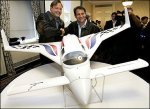Kev
Chairman of Selectors
- Joined
- Jun 19, 2004
- Online Cricket Games Owned
NEW YORK (AFP) - Personal spaceflight pioneer Peter Diamandis unveiled plans to take Formula One racing into the skies with rocket aircraft that will race around a three-dimensional course at up to 300 miles (480 kilometers) per hour.
Diamandis, the founder of the 10-million-dollar X Prize for private spaceflight, said his Rocket Racing League would seek to tap into the highly lucrative market enjoyed by Formula One and Nascar racing.
"It'll change the face of racing completely," he told reporters in New York.
The aerial racetracks will be approximately two miles (3.2 kilometers) long, one mile (1.6 kilometers) wide, and about 5,000 feet (1,520 meters) high, running perpendicularly to spectators.
The rocket planes, called X-Racers, will take off from a runway both in a staggered fashion and side-by-side and fly a course based on the design of a Grand Prix competition, with long straights, vertical ascents, and deep banks.
Each pilot will follow his or her own virtual "tunnel" or "track" of space, separated from their competitors by a few hundred feet.
"Of course it's risky," said Diamandis. "We're dealing with a new frontier."
Pilots will use state-of-the-art Global Positioning System (GPS) technology to reduce the chance of any mid-air collision.
The X-Racers, which are still in the development stage, are expected to cost around one million dollars each. They will be powered by a single 1,800 pound (800 kilogram) liquid and kerosene rocket engine.
Instead of a throttle, the racers will have a simple on/off switch to operate the rocket burner.
"It's either a glider, or it's a rocket, depending on which way the switch is clicked," said Rick Searfoss, a former space shuttle commander who will be among the first X-Racer pilots.
The vehicles will only carry around four minutes worth of fuel, forcing the pilots to exercise their judgment in choosing the optimal moments to fire the rocket burner.
"It will mean multiple shut-offs and relights," Searfoss said.
Four of the aircraft will be brought online in 2006 and the league expects to have 10 X-Racers competing by 2007.
The project envisages competitions across the United States, with annual finals at the X Prize cup in New Mexico.
Diamandis, an aerospace engineer turned entrepreneur, is best known for the X Prize which he offered to the first ever privately funded spaceflight.
The 10 million dollar reward was claimed in October last year by the rocket ship, SpaceShipOne, whose successful sub-orbital flight was seen as ushering in a new era of space tourism.
Diamandis said commercial success for his new racing league would generate new investment in rocket technology and provide a further boost to the nascent space tourism industry.
"It's all about making space flight accessible," he said.
Diamandis, the founder of the 10-million-dollar X Prize for private spaceflight, said his Rocket Racing League would seek to tap into the highly lucrative market enjoyed by Formula One and Nascar racing.
"It'll change the face of racing completely," he told reporters in New York.
The aerial racetracks will be approximately two miles (3.2 kilometers) long, one mile (1.6 kilometers) wide, and about 5,000 feet (1,520 meters) high, running perpendicularly to spectators.
The rocket planes, called X-Racers, will take off from a runway both in a staggered fashion and side-by-side and fly a course based on the design of a Grand Prix competition, with long straights, vertical ascents, and deep banks.
Each pilot will follow his or her own virtual "tunnel" or "track" of space, separated from their competitors by a few hundred feet.
"Of course it's risky," said Diamandis. "We're dealing with a new frontier."
Pilots will use state-of-the-art Global Positioning System (GPS) technology to reduce the chance of any mid-air collision.
The X-Racers, which are still in the development stage, are expected to cost around one million dollars each. They will be powered by a single 1,800 pound (800 kilogram) liquid and kerosene rocket engine.
Instead of a throttle, the racers will have a simple on/off switch to operate the rocket burner.
"It's either a glider, or it's a rocket, depending on which way the switch is clicked," said Rick Searfoss, a former space shuttle commander who will be among the first X-Racer pilots.
The vehicles will only carry around four minutes worth of fuel, forcing the pilots to exercise their judgment in choosing the optimal moments to fire the rocket burner.
"It will mean multiple shut-offs and relights," Searfoss said.
Four of the aircraft will be brought online in 2006 and the league expects to have 10 X-Racers competing by 2007.
The project envisages competitions across the United States, with annual finals at the X Prize cup in New Mexico.
Diamandis, an aerospace engineer turned entrepreneur, is best known for the X Prize which he offered to the first ever privately funded spaceflight.
The 10 million dollar reward was claimed in October last year by the rocket ship, SpaceShipOne, whose successful sub-orbital flight was seen as ushering in a new era of space tourism.
Diamandis said commercial success for his new racing league would generate new investment in rocket technology and provide a further boost to the nascent space tourism industry.
"It's all about making space flight accessible," he said.



